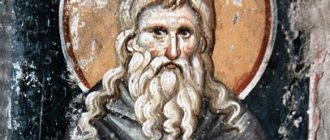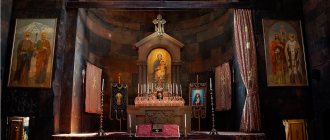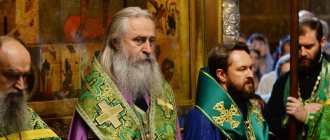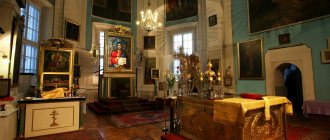Antimins - linen or silk cloth depicting the position of Christ in the Tomb
Antimins - (from Greek anti - “instead” and Latin mensa - “table”) is a board consisting of four corners and made of linen or silk. Particles of holy relics are sewn onto the upper side. Previously, only a cross was depicted on it, but now you can find a scene of the Savior’s position in the tomb, various instruments for executing executions and the four apostles.
Expanded antimension with the signature of the hierarch who consecrated the board
There is always a sponge on the antimind, which is called an antimind. With its help, small particles of the Body of Jesus and particles that were taken from the liturgical bread are collected in special dishes.
This item is also used to wipe the hands and lips of church ministers after receiving Communion. It acts as a symbol of the sponge that was brought to the lips of the Savior Crucified on the Cross.
Antimenses are divided into permanent and portable. The latter were created for camp churches, since there were opponents of the clergy who violated the cathedrals and carried out numerous repressions against believers.
The image on the ancient antimensions was only a cross, and the boards themselves were small in size
Ancient antimensions were performed by the priests themselves, who delivered them to the hierarchs for consecration. The images featured a variety of patterns, but in the 17th century. in Russia they began to produce monotonous boards. Later they began to produce antimensions, which were printed in a typographical way and depicted the position of Christ in the Tomb.
How the antimins is consecrated
Usually the bishop consecrates the antimension together with the temple in which this plate will be used during worship. To carry out the rite of consecration, one or more antimensions are rolled up in a special way and placed in a special dish, which is later placed on the altar.
Only persons of clergy may touch the antimins
During the consecration, the board is located in the place where the Gospel is usually placed. At this time, the Gospel itself is removed to that part of the altar where it usually stands after the end of the liturgy. Particles of holy relics, which will later be sewn up in the corner of the antimins, are placed on the paten. The paten itself is placed on the altar, and two lit candles are placed next to it.
Before the start of the rite of consecration, the priest dresses in special clothes, over which he puts on a white tunic. The bishop goes to the throne through the Royal Doors and reads all the necessary prayers, which are traditionally read during the consecration of the temple.
To the right of the throne, to carry out the rite of consecrating the antimensions, the bishop’s assistants install three vessels: one of them contains wine, the other contains rose water, the third remains empty. The bishop combines wine and water in the third vessel, and sprinkles the antimensions with the resulting liquid three times.
Interesting to know! The water obtained by mixing rose water and wine is called joyful.
Next, on each antimension the bishop places a cross with a brush dipped in the Holy Myrrh. Accompanied by other priests, the bishop approaches the altar, picks up the prepared paten with relics and, together with it, walks around the throne twice.
Then the paten is placed on the throne next to the antimensions, and at this time the bishop goes around the Holy Table for the third time, completing the rite of consecration with incense and reading the 25th Psalm. After reading the closing prayers, the archbishop leaves the altar. Upon completion of all necessary procedures, the hours and traditional divine liturgy begin.
In ancient times, the antimension was used instead of a table, but now the liturgy is not celebrated without it
Antimensions in the Orthodox Church are an integral part of church services, without which not a single liturgy is celebrated. It is on them that the consecration of the Holy Gifts is performed.
Antimens
an integral part of any of their church services
As the saint of the Russian Orthodox Church Simeon of Thessalonica said, on the antimensions “everything is done that is done at the divine meal (Liturgy). When necessary, at the discretion of the bishop, they, completely sanctified, are sent to places where there is no altar [throne], and the divine rite of the Mysteries is performed on them.”
The plate is considered the so-called “bishop's letter”, on which the signature of the priest who consecrated and taught this plate is left.
In the photo, the bishop has arranged the Holy Gifts for consecration and is ready for the liturgy
In Rus', antimensions in the Orthodox Church were initially used instead of a throne (a table whose location was in the center of the altar), previously illuminated by the patriarch.
Only towards the end of the 17th century did it become mandatory to have an antimension on the “holy table”, even if it had been consecrated in advance by the bishop. Now this item of church rite, closed, is always on the throne of the Orthodox Church under the Gospel and is dressed in an iliton - a large cloth.
Orthodox Life
Priest Andrei Chizhenko answers.
Antimins is a rectangular cloth cloth made of silk or linen (smooth fabric on which it is easy to pick up particles of the Body of Christ or proskomedia particles: from priestly practice). The antimension itself is an embroidered icon of the position of the Savior in the tomb, i.e., the image of the Body and Blood of Christ - the main shrine of the Liturgy, for which it is intended.
At the corners of the antimension there are icons of the four evangelists. Often on it, near the Body of Christ, the faces of the Most Holy Theotokos, the holy apostle and evangelist John the Theologian, the myrrh-bearing women, the righteous Joseph of Arimathea and Nicodemus are embroidered - those persons who participated in the burial of our Lord Jesus Christ.
Also, on the ancient Greek antimensions there could simply be an image of the Crucifixion. In the middle of the antimension, on the reverse side, a piece of the relics of some saint is sewn into a special pocket, taken on wax and attached to it.
The right to consecrate antimensions belongs to the bishop, therefore he must sign it, often indicating for which church and which locality it is intended. A special sponge is also placed on the antimension in order to collect particles of the Body of Christ and proskomedia particles for more convenient consumption by the priest.
During the Liturgy, at certain moments of the service (when remembering the Patriarch, the Primate of the Church and the Ruling Bishop at the special litany after the reading of the Holy Gospel), the antimension is unfolded, only its upper part is left closed. It is revealed immediately before the Cherubic Hymn at the petition “He will reveal to them the Gospel of Truth” in the litany of the catechumens.
During the service of the Liturgy of the Faithful and its main part - the Eucharistic Canon, at which the transubstantiation of the Holy Gifts takes place, the antimension is open. In fact, the great Sacrament of the Eucharist takes place on it. It closes before the end of the Divine Liturgy, when the priest, on behalf of all believers, thanks the Lord for the fact that the Almighty has granted people the communion of the Holy Mysteries of Christ. The sponge is placed in the center of the antimins, it itself is folded into an envelope and wrapped in another larger board, usually red, which is also folded into an envelope.
The priest, both at the beginning of the Liturgy and at the end, cross-blesses the antimension with the Holy Altar Gospel and places it on top of the folded orithon with the antimension inside. It remains on the antimension all the time, unless the Divine Liturgy is served. The red color of the orithon is, of course, a symbol of the Blood of Christ shed for us. The word “iliton” is Greek and translated into Russian as wrapper. It symbolizes the sir (from the Church Slavonic language of plates), with which the head of the Savior was entwined during burial.
The antimension itself symbolizes, as mentioned above, the Body of Christ laid in the tomb.
The word "antimins" is of Greek and Latin origin. The Greek prefix “anti” means “instead”, and the Latin “mensa” means “table”, “meal”. That is, the word “antimins” means “instead of the throne” and this reflects its historical function in church worship. The use of antimensions during the celebration of the Liturgy is a very ancient tradition, dating back to the first centuries of Christianity.
Often church communities led by bishops or priests did not have the opportunity to build temples in the Roman Empire. Christians had to serve secretly, in the catacombs, and move from place to place in order to survive in an aggressive pagan environment. Initially, the “in place of the throne”-antimension was a disassembled light wooden consecrated table, replacing the Holy Meal (throne) in marching conditions or in conditions of persecution.
This practice existed at the beginning of the 4th century in the troops of the holy Equal-to-the-Apostles Emperor Constantine the Great, where there were many Christians. It was used in military and missionary campaigns. During the persecutions of the first centuries, the antimension was laid out or destroyed, if it was made of material, at the graves of martyrs, where the Liturgy was often served. This is where the later tradition of sewing into the antimension the relics of martyrs, and then other saints, originates.
At the beginning of the 20th century, a mournful and sorrowful practice appeared in the USSR, somewhat similar to the ministry of persecuted Christians of the first centuries. In it, the priest’s chest served as both a throne and an antimension. For example, in the twenties and thirties of the last century, many bishops and priests were arrested and exiled to the Solovetsky special purpose camp, where they were kept in terrible conditions. Every day they expected death. In this almost continuous horror of life, as on the last day, of course, they wanted to serve the Liturgy for salvation and consolation. They served her like this...
At risk to themselves (performing religious rituals was punishable by execution), bishops, priests, and deacons met secretly. One of them undressed to the waist and lay down. His body, like the body of a priest over whom the Sacrament of Ordination was performed, served as a throne and antimension. On it, on cranberry juice and black bread, in the absence of wine and prosphora, the Liturgy was celebrated. And many of those who suffered for the faith of Christ were later awarded martyrdom and holy crowns.
Holy new martyrs and confessors who have shone forth in the Russian land, pray to God for us!
For the first time in church literature, the word “antimension”, almost in its modern meaning, is used in the life of the Venerable Marcian of Syracuse (beginning of the 8th century), where this word refers to the portable altar on which the saint celebrated the Liturgy.
Later, antimensions were widely used in the Church during the iconoclastic persecutions (8th–9th centuries), when heretics desecrated churches and resumed mass repressions against Orthodox icon-worshippers.
The Decree of the VII Ecumenical Council (787), which ended the iconoclastic era with the victory of Orthodoxy and the restoration of the veneration of holy icons and relics, says: “If any honorable churches were consecrated without the holy relics of the martyrs, we determine: let the position of the relics be performed in them with the usual prayer "(rule 7).
The Greek Church maintained the tradition of placing the relics of martyrs in antimensions, when the priest received a blessing and, accordingly, an antimension with relics from the Ruling Bishop in order to serve in a church with an unconsecrated altar. Saint Simeon of Thessalonica testifies to this: “Antimins are made from linen fabric and are used instead of a sacred meal. They are sewn and prepared in advance, as required by the Rule, and everything that is done at the Divine Table is performed on them. When necessary, at the discretion of the bishop, they, completely sanctified, are sent to places where there is no altar, and the divine rite of the Mysteries is performed on them.”
In the tradition of the Russian Orthodox Church, according to some historical data, it was customary to place relics not in the altar, but in the antimension itself, since churches were mainly built wooden and quite often suffered from fires. An antimension is still easier to bear than a throne. The Moscow Council of the Russian Orthodox Church in 1675 decided to have an antimension in churches, even on the consecrated altar. Without an antimension, the celebration of the Divine Liturgy is impossible.
Also, the liturgical use of antimensions also has a church-disciplinary component. The antimension is consecrated by the Ruling Bishop legally installed in a certain diocese, signed by him and given to the priest for worship in the established parish. Thus, this is a symbol of apostolic succession and confirmation that the clergyman belongs to the canonical church hierarchy.
Antimins is one of the main shrines of the Orthodox church. He is constantly on the throne. Only a clergyman can touch it, dressed minimally in a cassock, epitrachelion and braces, and maximally in full priestly vestments for serving the Divine Liturgy.
Why are the relics of saints placed in the antimension? With God's help, let us answer this question not only in a concrete historical, but also in a spiritual, dogmatic sense.
The basis for venerating the relics is the Incarnation of the Son of God, our Lord and Savior Jesus Christ. Having taken upon himself human nature, the Savior sanctified it in its entirety and thereby forever established the dignity of human corporeality. Let us also remember that Christ ascended into heaven and sat down at the right hand of the Throne of God the Father, not only as true God, but also as true Man - in human spiritual and physical nature. Therefore, for Orthodox Christians, the body is one of the levels of the human personality, the connection with which the person retains even after death. Let us remember the words of the Holy Chief Apostle Paul: “Do you not know that your body is the temple of the Holy Spirit who dwells in you, which you have from God, and you are not your own?” (1 Cor. 6:19).
This is where the veneration of the holy relics of the great saints of God comes from, who during their lifetime, both mentally and physically, became the abode of the Holy Spirit. The Monk Silouan of Athos wrote the following about the relics: “Whoever has grace in both soul and body has perfect love” (154), for “perfect love” leads to the transformation of the body: The fourth, perfect love for God is when someone has grace The Holy Spirit in both soul and body. His body is consecrated, and his relics will be (145).”
This body, transformed by the grace of the Holy Spirit, bearing His seal even after death, becoming His abode for all eternity, we honor with reverence. Moreover, the Orthodox worship not so much the bones themselves, but the power of God revealed in the relics of this or that saint of God. This is where the very name of such remains “relics” comes from, that is, the power, the power of God. Therefore, they are, of course, like precious stars reflecting Divine light.
In sewing the relics of saints into the antimensions there is something of the visible tangible connection of the heavenly Church with the earthly Church, which unites the heavenly and earthly Orthodox army with God's blessing into one whole - the Body of Christ. In Him, Christ, the Most Holy Theotokos with the heavenly Angels and all the saints are with us in one majestic doxology of love, which is the Divine Liturgy.
Priest Andrey Chizhenko
Holy relics are necessary in order not to forget about the ancient Christians
In order to use the antimension for its intended purpose, you need to perform a small ceremony. The saint moistens it with red wine combined with rose water, anoints it with holy myrrh and places holy relics in it.
All this is necessary in order to preserve the memory of the ancient Christians who built churches and held services at the tombs of the great martyrs.
It is prohibited to consecrate antimensions without placing holy relics on them.
In case of violation of the prohibition by the bishop, “let him be deposed, as if he had violated Church Tradition.”
The veneration of holy relics occurs because Jesus Christ takes on the image of human essence. Thus, the Son of God strengthened the significance of the human body, and then he sat down at the right hand of the Father not only as a real God, but also as a real Man - in the human mental-physical essence.
Literature
- Alekseeva
M.A. Little-known works of Russian art of the 17th and first half of the 18th centuries. - engravings on antimensions // Cultural monuments: New discoveries, 1982. Leningrad, 1984. - Antimins // Encyclopedic Dictionary of Brockhaus and Efron: in 86 volumes (82 volumes and 4 additional). - St. Petersburg, 1890-1907.
- Antimins // Ankylosis - Bank [Electronic resource]. - 2005. - P. 50. - (Big Russian Encyclopedia: [in 35 volumes] / chief editor Yu. S. Osipov; 2004-2017, vol. 2). — ISBN 5-85270-330-3.
- Belyaev
D.F. Daily receptions of Byzantine kings and their festive exits to the Church of Hagia Sophia in the 9th-10th centuries. // Notes of the Imperial Russian Archaeological Society. St. Petersburg, 1893. - Benjamin, Archbishop of Nizhny Novgorod
. A new tablet, or an explanation about the Church, about the liturgy and about all the services and church utensils. St. Petersburg, 1899. - Goshev
I. Antimins: This research is liturgical and ecclesiastical and historical. Sofia, 1925. - Dolotsky
V. On the significance and antiquity of actions performed during the consecration of churches // Christian Reading. Part II. 1844. - Zheltov M. S., Popov I. O., Silkin A. V.
Antimins // Orthodox Encyclopedia. - M.: Tserkovno-nauchny, 2001. - T. II: “Alexy, man of God - Anfim Ankhialsky.” — P. 489-493. — 752 p. — 40,000 copies. — ISBN 5-89572-007-2. - Zagraevsky
S.V. "Antimins" from the St. Nicholas Cathedral. M., 2004. - A clergyman's handbook. - M.: Publishing Council of the Russian Orthodox Church.
- Nikolsky K.T., archpriest.
On the antimensions of the Orthodox Russian Church. - M.: Novospassky Monastery, 2012. - 220 p. — 1000 copies. - Nikolsky K.T., archpriest.
A guide to the study of the Charter of Divine Services of the Orthodox Church. — 7th ed. - St. Petersburg: Synodal Printing House, 1907. - P. 7-8. — 894 p. Archived copy from March 5, 2021 on the Wayback Machine - Petrovsky A.V. Antimins // Orthodox Theological Encyclopedia. Volume 1. Petrograd edition. Supplement to the spiritual magazine “The Wanderer” for 1900.
- On the antimensions of the Orthodox Church // Moscow Diocesan Gazette. 2005. No. 3-4.
- A complete collection of decrees and orders for the Department of Orthodox Confession of the Russian Empire. T. III: 1723. St. Petersburg, 1875. No. 1120, 1132.
- A complete collection of decrees and orders for the Department of Orthodox Confession of the Russian Empire. Reign of Emperor Paul I: 6. XI. 1796-11. III. 1801. Pg., 1915. No. 116, 548, 553.
- Prilutsky
V. Private worship in the Russian Church. Kyiv, 1912. - Tsvetkov
I.F. About the ancient antimensions located in the Kaluga bishop's sacristy, in connection with the history of the antimensions in general. // Kaluga antiquity. T.III. Kaluga, 1903. - The rite of consecration of the temple and the position of venerable relics in the Byzantine Euchologia of the 11th century. // Relics in the art and culture of the Eastern Christian world. M., 2000.
The placement of holy relics is an invisible thread that connects the earthly temple with the heavenly temple
When holy relics are placed in the antimension, many priests find in this process a tangible thread connecting the earthly temple with the heavenly temple. The earthly Orthodox army is drawing closer with God's blessing into one part - the Body of Christ.
In Him, Christ, the Most Holy Theotokos with the heavenly Angels are with us in one magnificent doxology of love, which is the Divine Liturgy.
When the antimension is consecrated, the same sacred actions are performed over it as are done over the saint. throne. For example, the same rituals are performed, the same words and prayers are pronounced, and similar chants are sung.
Iliton performs a practical function: particles that fall on it can be easily removed
The vessels for Communion stand on the antimension on top of the iliton, which is unrolled only for the celebration of the liturgy.
Iliton is a red linen or silk liturgical cloth, which is kept on the “holy table.” It is no coincidence that this color was chosen. It symbolizes the blood of Jesus Christ shed for people. Iliton is necessary to wrap antimins.
Iliton is unfolded only during the Divine Liturgy. Also on it are vessels with the consecrated Holy Gifts (Eucharistic bread and wine).
The oriton for the antimension must be larger in size and must be consecrated by the bishop.
The use of the orithon for worship is that it is spread out on the “holy table” shortly before the Holy Gifts are placed on it and folded back at the moment when, at the end of the liturgy, the Eucharistic Gifts are removed from the throne.
In this way, reverence for the Holy Gifts is expressed. The stretching of iliton also has a practical orientation. For example, if particles of the Holy Gifts fall from a liturgical vessel, they will remain on the orithon and can be easily collected, and the deacon can use them at the end of the service.
The fabric used for the production of iliton is predominantly dark red or purple in color, in order to easily detect light particles on it.
The red color of iliton is associated with the blood of the Savior, which he shed for people
In Greek churches, the holy relics of martyrs are sewn into the antimins
In the Greek Church, the custom remained of sewing the holy relics of martyrs into the antimension, as well as using it from the Ruling Priest to conduct services in a church with an unconsecrated altar.
The boards that were used in Greek churches were made, as Simeon of Thessalonica said, from linen, on the edges they had drawings depicting the evangelists and the inscription: “the altar of the saint, the name of the rivers who officiated from the patriarch, the name of the rivers, the month of which and in the summer.”
The production, preservation and transfer of antimensions was the obligation of what was popularly called the “chief of the antimensions.”
In Western countries of the Orthodox tradition, the role of the antimins is played by the corporal, usually made of white fabric.
Corporal
analogue of the antimins in the Orthodox tradition of Western countries
The antimension is a significant detail in the celebration of the Divine Liturgy in the Orthodox world, and for many centuries this tradition has been preserved, although it has undergone some changes.
Despite this, some clergy consider the use of board, instead of liton, to be incorrect.
By leaving a comment, you accept the user agreement
Notes
| External images | |
| |
| |
- Archpriest Grigory Dyachenko.
Conversation No. 4 “On the arrangement of the altar” // Orthodox Church. - Kyiv: Prologue, 2005. - P. 70. - 282 p. — ISBN 966-8538-20-X, BBK 86.37-505, UDC 2-523.4; D 93. - ↑ 12
Orthodox encyclopedia "ABC of Faith" - Teacher's news // Service book. - M.: Moscow Patriarchate, 1977. - T. 2. - P. 487. - 608 p.
- M. S. Zheltov, I. O. Popov, A. V. Silkin.
Antimins // Orthodox Encyclopedia. - M.: Tserkovno-nauchny, 2001. - T. II: “Alexy, man of God - Anfim Ankhialsky.” — P. 489-493. — 752 p. — 40,000 copies. — ISBN 5-89572-007-2. - Orthodox encyclopedia "ABC of Faith", photo album of priest Konstantin Parkhomenko
- Bishop's official. book 1 peza of relics (translated from the Greek writing of the official)
- Explanation of Orthodox services, rituals and sacraments. Blessed Simeon of Thessalonica. p.136. Oranta Publishing House. 2010.
- See: Zagraevsky S.V. The question of the authenticity of the 12th century antimension from the St. Nicholas Cathedral
- A. V. Petrovsky, Orthodox Theological Encyclopedia - “Antimins”
- Catholic Encyclopedia New Advent, article "Antimins"
- Catholic Encyclopedia New Advent, article "Corporal"
- Kolupaev V.Ukrainian Greek-Catholic antimensions of the 20th century in Russian liturgical practice // Metron # 12, Lviv, 2015







